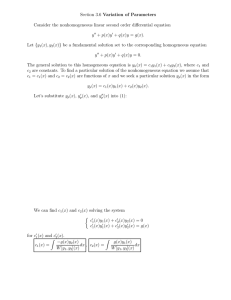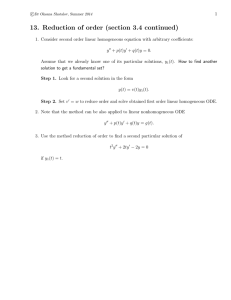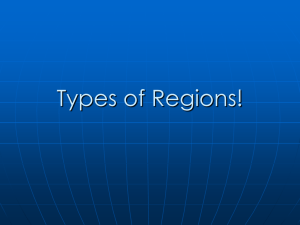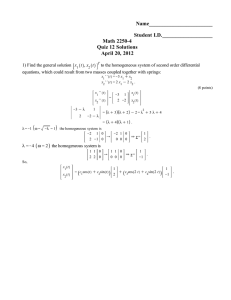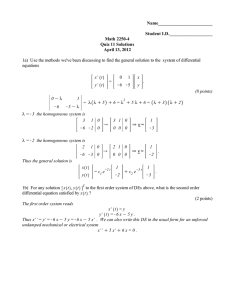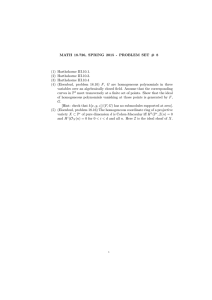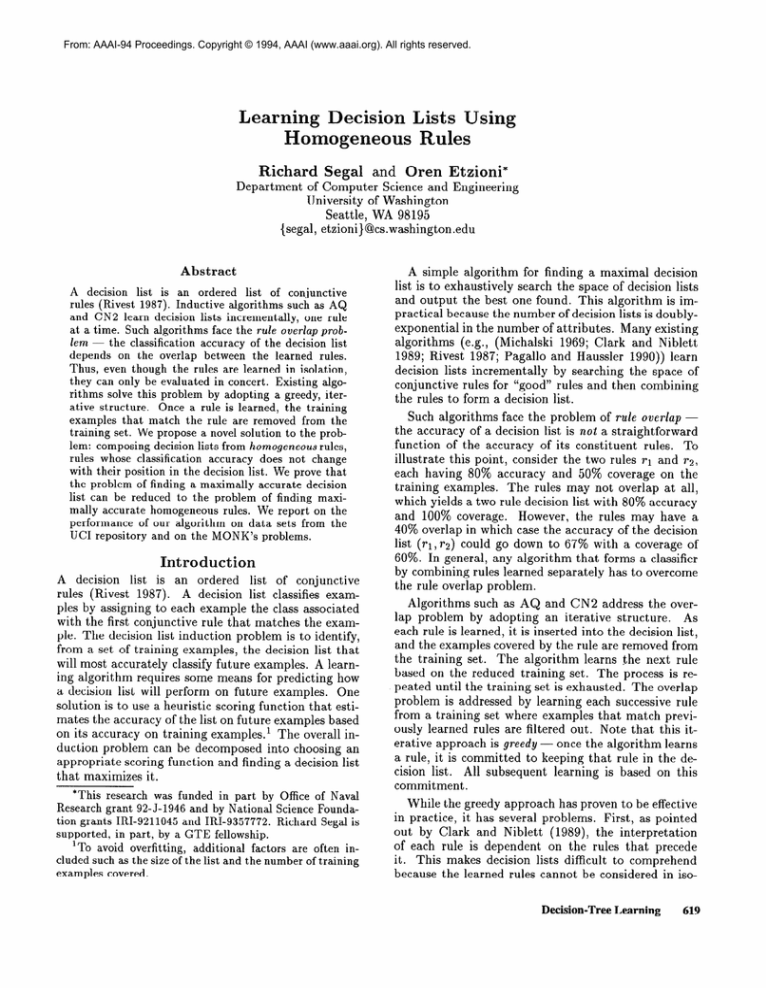
From: AAAI-94 Proceedings. Copyright © 1994, AAAI (www.aaai.org). All rights reserved.
Learning Decision Lists Using
Homogeneous
Richard
Segal
and Oren Etzioni*
Department
of Computer Science and Engineering
University of Washington
Seattle, WA 98195
{segal, etzioni)@cs.washington.edu
Abstract
A decision
list is an ordered
list of conjunctive
rules (Rivest 1987). Inductive algorithms
such as AQ
and CN2 learn decision lists incrementally,
one rule
at a time. Such algorithms
face the rule overlap problem the classification
accuracy
of the decision list
depends on the overlap between the learned rules.
Thus, even though the rules are learned in isolation,
they can only be evaluated in concert.
Existing algorithms solve this problem by adopting a greedy, iterative structure.
Once a rule is learned, the training
examples that match the rule are removed from the
training set. We propose a novel solution to the problem: composing decision lists from homogeneous
rules,
rules whose classification
accuracy
does not change
with their position in the decision list. We prove that
the problem of finding a maximally
accurate
decision
list can be reduced to the problem of finding maximally accurate
homogeneous
rules. We report on the
performance
of our algorithm
on data sets from the
UC1 repository
and on the MONK’s problems.
Introduction
A decision
list is an ordered
list of conjunctive
rules (Rivest 1987).
A decision list classifies examples by assigning to each example the class associated
with the first conjunctive rule that matches the example. The decision list induction problem is to identify,
from a set of training examples, the decision list that
will most accurately classify future examples. A learning algorithm requires some means for predicting how
a decision list will perform on future examples.
One
solution is to use a heuristic scoring function that estimates the accuracy of the list on future examples based
on its accuracy on training examples.’ The overall induction problem can be decomposed into choosing an
appropriate scoring function and finding a decision list
that maximizes it.
*This research
was funded in part by Office of Naval
Research grant 92-J-1946
and by National Science Foundation grants IRI-9211045
and IRI-9357772.
Richard Segal is
supported,
in part, by a GTE fellowship.
lTo avoid overfitting, additional factors are often included such as the size of the list and the number of training
examples covered.
A simple algorithm for finding a maximal decision
list is to exhaustively
search the space of decision lists
and output the best one found. This algorithm is impractical because the number of decision lists is doublyexponential in the number of attributes.
Many existing
algorithms
(e.g., (Michalski
1969; Clark and Niblett
1989; Rivest 1987; Pagallo and Haussler 1990)) learn
decision lists incrementally
by searching the space of
conjunctive rules for “good” rules and then combining
the rules to form a decision list.
Such algorithms face the problem of rude overlap the accuracy of a decision list is noi a straightforward
function of the accuracy of its constituent
rules. To
illustrate this point, consider the two rules ~1 and ~2,
each having 80% accuracy and 50% coverage on the
training examples.
The rules may not overlap at all,
which yields a two rule decision list with 80% accuracy
and 100% coverage.
However, the rules may have a
40% overlap in which case the accuracy of the decision
list (fr,73)
could go down to 67% with a coverage of
60%. In general, any algorithm that forms a classifier
by combining rules learned separately has to overcome
the rule overlap problem.
Algorithms such as AQ and CN2 address the overlap problem by adopting an iterative structure.
As
each rule is learned, it is inserted into the decision list,
and the examples covered by the rule are removed from
the training set. The algorithm learns the next rule
based on the reduced training set. The process is repeated until the training set is exhausted.
The overlap
problem is addressed by learning each successive rule
from a training set where examples that match previously learned rules are filtered out. Note that this iterative approach is greedy - once the algorithm learns
a rule, it is committed
to keeping that rule in the deAll subsequent
learning is based on this
cision list.
commitment.
While the greedy approach has proven to be effective
in practice, it has several problems.
First, as pointed
out by Clark and Niblett (1989), the interpretation
of each rule is dependent
on the rules that precede
it. This makes decision lists difficult to comprehend
because the learned rules cannot be considered in isoDecision-TreeLearning
619
lation.
Second, on each iteration,
fewer training examples are available for the learning algorithm, which
hinders the algorithm’s
ability to learn. This is particularly important
in situations
where training data
Finally, poor rule choices at the beginning
is scarce.
of the list can significantly
reduce the accuracy of the
decision list learned.
Nevertheless,
Rivest showed that a greedy, iterative
algorithm can provably PAC learn the concept class
k-&5, decision lists composed of rules of length at most
X: (Rivest 1987). However, Rivest’s PAC guarantee presupposes there exist 100% accurate rules of length at
most rE that cover the training examples.
This strong
assumption
neatly sidesteps the overlap problem because the accuracy of a 100% accurate rule remains
unchanged regardless of the rules that precede it in
the decision list. However, the assumption is often violated in practice. A full complement of 100% accurate
rules of length at most Ic cannot be found when there
is noise in the training data, when the concept to be
learned is not in k-DL (relative to the algorithm’s attribute language), or when the concept is probabilistic.
Our main contribution
is a solution to the overlap problem that is both theoretically
justified
and
practical.
We borrow the notion of homogeneity from
the philosophical literature (Salmon 1984) to solve the
overlap problem in learning decision lists. Informally,
a homogeneous
rule is one whose accuracy does not
change with its position in the decision list.
Formally, let E denote the universe of examples. Let
T denote the set of tests within a domain and G the
set of goal classes. Let DL denote the set of all decision
lists. Let c(e) denote the classification
of example e,
that decision list
and C(e, d) d enote the classification
d assigns to the example e. We write a rule as A -+ g,
where A C T and g E G. When an example e passes
all the tests in A, we say e E A. Let P be a probability
distribution over examples. We define the accuracy of
a decision list d with respect to P as follows:
A(d)
=
c
P(e)
eEElc(e)=C(e,d)
We define the accuracy of a rule to be its accuracy
the examples that it covers:
on
A homogeneous
rule is a rule for which all specializations of the rule have the same accuracy as the rule
itself. Formally, a homogeneous
rule is a rule A --+ g
such that, for all B c T, the following holds:
a(A A B + g) = a(A + g)
All 100% accurate rules are homogeneous, but homogeneous rules need not be 100% accurate.
Thus, homogeneity can be viewed as a generalization
of Rivest’s
solution to the overlap problem.
This generalization
620
Machine Learning
is valuable in situations where concise 100% accurate
rules do not exist.
Our algorithm for learning decision lists, BRUTEDL,
searches the space of conjunctive
rules for maximally
accurate homogeneous
rules and composes the rules
found into a decision list. The remainder of the paper is organized as follows.
The next section introduces the theory underlying BRUTEDL.
The following
section explains the approximations
to the theory we
use to make BRUTEDL
practical.
We then describe
BRUTEDL’S
algorithm and discuss how we make our
Finally, we present empirimplement at ion efficient.
ical results that validate our approach and compare
BRUTEDL
with related algorithms.
omogeneous
Decision
Lists
This
section
describes
the
theory
underlying
BRUTEDL.
Our goal is to demonstrate
that the problem of finding a maximally accurate decision list can be
reduced to the problem of finding maximally accurate
homogeneous rules.
A homogeneous
decision list is a decision list composed exclusively of homogeneous rules. We use HDL
to refer to the set of all homogeneous
decision lists.
BRUTEDL
is restricted
to learning homogeneous
decision lists. Does this restriction
mean that in some
cases BRUTEDL will be forced to learn an inferior decision list? In other words, are there cases where the
best homogeneous
decision list is less accurate than
the best decision list?
The answer is no.
We say
that two decision lists d and d’ are dogicadly equivalent if they classify all examples identically.
That is,
b’e E E, C(e, d) = C(e, d’).
Theorem
mogeneous
Proof
1 For every decision list, there exists a hodecision list that is logically equivalent.
sketch:
Let d be a nonhomogeneous
decision list and r = A --)
g be a nonhomogeneous
rule in d. We can replace r
with a set of equivalent homogeneous
rules. By performing this replacement for all nonhomogeneous
rules
in d, a homogeneous
decision list logically equivalent
to d can be found. Let t be any test not in A. The
rule r can be replaced with A A t + g and A A 4 -+ g
without changing how d classifies examples.
If these
rules are homogeneous,
we are done. If not, we can repeat the procedure and replace the two rules with four
rules without logically changing d. This procedure can
be repeated until a set of homogeneous rules is found.
A set of homogeneous rules is guaranteed to be found
because there is a finite number of tests.0
Our solution to the overlap problem combines the
notion of homogeneity with the intuition that the best
rule to classify any given example is the most accurate
rule that covers the example.
We define a maximal
cover as a set of rules containing, for each example, the
most accurate homogeneous
rule that covers it. Formally, let hr(e) be the set of homogeneous
rules that
match e. A maximal cover M(E)
of a universe of examples E is any set of homogeneous
rules for which
the following holds:
V eEE,
3 rEM(E)
such that a(r)
=T phyel a(r’)
I
We now show that the problem of finding the maximally accurate decision list can be reduced to the problem of finding a maximal cover for E.
Theorem 2 Any homogeneous
decision list d whose
rules form a maximum
cover of E and is sorted by
decreasing accuracy will have:
A(d)
= dial
I
A(b)
Proof:
First we prove that d must be a maximally
accurate homogeneous
decision list. Assume that A(d) #
There must exist a homogeneous
maxd,EHDL A(d’).
decision list f such that A(f)
> A(d).
Let e denote
an example that is classified by a rule fi in f and dj
in d such that u(fi) > u(dj).
Since A(f)
> A(d),
The rules of d form
such an example must exist.
a maximum cover; therefore,
there exists a dk such
Furthermore,
we have
that u(dk) = milX,.Ehqej u(r).
We have k < j
a(&)
> u(h) b ecause fi E hr(e).
because u(dk) 2 u(fi) > a(dj) and d is sorted by decreasing accuracy.
But if k < j, e should have been
classified by dk rather than dj. This contradiction
establishes that A(d) = maxd,E HDL A(d’).
Let g be a
decision
list such that
A(g)
= maxd,E DI, A( d’).
As-
sume A(g) > A(d).
By Theorem
1, there exists an
h E HDL that is logically equivalent to g. We have
A(h) = 4s)
b ecause h and g are logically equivalent.
But since h is homogeneous,
we have A(d) 2
Thus,
A(h) = A(g) w h ic h contradicts the assumption.
A(d) = maxdlEDL A(d’).n
Implications
for
BRUTEDL
We now consider the implications
of Theorem
2 for
BRUTEDL.
If BRUTEDL
had access to the probability
distribution
P and the set of homogeneous
rules, it
would be straightforward
to build an algorithm based
on Theorem 2. In practice, BRUTEDL
is only given a
set of training data from which it must approximate
P
and determine which rules are homogeneous.
BRUTEDL
uses LapZaceAccuracy
as an approximation of the actual accuracy of a rule (Niblett
1987).
Let T be a rule that classifies rp training examples correctly out of the TV training examples it matches. Let
[Gl denote the number of goal classes. The LaplaceAccuracy of r is calculated as follows:
LapZaceAccurucy(r)
rp + 1
= rn + IGI
Once an estimate for the accuracy of individual rules
h as been defined, it is possible to check whether a
rule is homogeneous.
The accuracy of a homogeneous
rule should not change when additional conjuncts are
Therefore,
homogeneity
can be checked by
added.
comparing
the LaplaceAccuracy
of a rule with the
LaplaceAccuracy
of all the rule’s specializations.
Since
LaplaceAccuracy
is an approximation
to the actual accuracy of a rule, a rule is considered homogeneous
if
all specializations
have roughly the same LaplaceAccuracy. We check for statistically
significant differences
in LaplaceAccuracy
using a x2 test.
Although not required by Theorem 2, it is desirable
that the rules learned by BRUTEDL
do not contain irrelevant conjuncts.
An irrelevant conjunct is any conjunct whose presence does not affect the accuracy of a
rule. We will call any rule with only relevant conjuncts
minimal. Restricting
BRUTEDL
to minimal rules does
not affect the class of concepts it can learn because, for
every nonminimal
homogeneous
rule, there is a minimal rule with identical accuracy and greater coverage
that is formed using some subset of the original rule’s
conjuncts.
We check whether a conjunct is relevant by
checking if the accuracy of the rule changes when the
conjunct is removed. Again, we use a x2 test to ensure
that any differences in accuracy that are detected are
significant.
Algorithm
The previous sections developed the basic framework
behind BRUTEDL.
We now describe how this frameis a
The core of BRUTEDL
work is implemented.
depth-first search to find, for each example, the best
conjunctive
rule that covers it. Rules that are neither homogeneous nor minimal are filtered out. Once
a maximal cover has been found, the cover is sorted,
and a default rule is appended.
BRUTEDL
limits its
search to a fixed depth bound when it is too costly to
search the entire space. A pseudo-code description of
BRUTEDL
appears in Table 1.
The search performed by BRUTEDL
is systematic,
it visits each rule exactly once. In a naive search of
the space of conjunctive
rules, the identical rules A A
--) g would be visited separately:
B--,gandBAA
once while searching the children of A + g and once
while searching the children of B --+ g. BRUTEDL
achieves systematicity
by imposing a canonical order
on the tests within a rule. BRUTEDL
assigns a numeric
rank to each test and only considers rules whose tests
appear in order of increasing rank.
Homogeneity is checked by doing a systematic search
of all specializations
of a rule. If a specialization
is
found with a difference in accuracy that is considered
statistically
significant, the homogeneity check fails. If
no such specialization
is found, the rule is deemed hoBRUTEDL
limits the cost of homogeneity
mogeneous.
checks by reducing their frequency. It is only necessary
to check the homogeneity of a rule that is minimal and
is the best rule seen thus far for some example.
If
a rule does not meet these two criteria, it cannot be
Decision-TreeLearning
621
BruteDLO
DecisionList := MakeEmptyDLO;
BruteSearch(MakeEmptyRule0);
Sort(DecisionList);
AddDefaultRule(DecisionList);
END
BruteSearch(rule)
IF Length(rule) >= MaxLength THEN EXIT;
StartTest := FollowingTest(LastTest(rule));
FOR test := StartTest to LastTest DO
newrule := AddConjunct(rule, test);
IF BestForSomeExample(newrule) AND
IsMinimal(newrule) AND
Homogeneous(newrule,newrule)
THEN Insert(newrule,DecisionList);
IF NOT PruneRule(newrule)
THEN BruteSearch(newrule);
END
END
Homogeneous(ParentRule, ru1e):boolea.n
IF Length(rule) >= MaxLength THEN RETURN(True);
IF rule = ParentRule
THEN StartTest = 1;
ELSE StartTest = FollowingTest(LastTest(rule));
FOR test := StartTest to LastTest DO
newrule := AddConjunct(rule,test);
IF NOT SimilarAccuracy(ParentRule,newrule) THEN
RETURN(False);
ELSE IF NOT Homogeneous(ParentRule,newrule) THEN
RETURN(False);
END
RETURN(True);
END
IsMinimal(rule):boolean
FOR test in Conjuncts(rule) DO
ParentRule := DeleteConjunct(rule, test);
IF SimilarAccuracy(ParentRule, rule)
THEN RETURN(False);
END
RETURN(True);
END
Table
1: Pseudo-code
for BruteDL.
part of the final decision list. Using this filter, a homogeneity check is required for only a small fraction
of the rules searched.
Furthermore,
the homogeneity
check for a nonhomogeneous
rule is often inexpensive
because the search is terminated
once a specialization
with a significant difference in accuracy is found.
Once a maximum cover has been found, BRUTEDL
uses it to build a decision list. The final decision list
is formed by sorting the maximum cover and appending a default rule. A default rule is necessary because
the rules found by BRUTEDL,
although required to
cover the training examples,
might not cover all the
test examples.
BRUTEDL
appends a default rule that
predicts the most frequent class in the training data.
622
Machine Learning
(1) IfAccuracy(r)= 100% then Prune(r).
(2) IfMatchedPositives < MinPositivesthen Prune(r).
(3) IfMatchedNegatives(AA-c) < MinSimNegatives A
MatchedPositives(AA-c)< MinSimPositivesthen
Prune(AAc).
Table 2: Pruning axioms used by BRUTEDL.
Prune(r)
indicates the children.of T should not be searched. The
axioms are sound because the rules they prune cannot
be part of the final decision list.
Efficiency
For BRUTEDL to be a practical algorithm, it is important that it be as efficient as possible. The efficiency of
BRUTEDL is determined by two factors: the efficiency
of processing each rule and the number of rules processed.
We address the first element of BRUTEDL’S
efficiency by carefully implementing
BRUTEDL
in C.
BRUTEDL
can process approximately
100,000 rules
per second when running on a SPARC-10.
processor
with a data set of 500 examples.
BRUTEDL’S
running time grows linearly with the number of examples.
Significant, improvements
in program efficiency are not
expected because BRUTEDL
is currently within an order of magnitude of the machine’s clock rate. However,
further improvements
in rule processing speed will occur as faster machines become available.
The second element of BRUTEDL’S
efficiency is the
BRUTEDL
can reduce
number of rules it processes.
the number of rules it has to process by pruning away
not to be part of the final decision
rules guaranteed
list. BRUTEDL
uses the axioms in Table 2 to determine the portions of the search space it can ignore.
BRUTEDL’S
pruning axioms significantly
reduce the
For the test donumber of rules it has to process.
mains presented later, the pruning axioms reduced the
search space by as much as a factor of 1,000. The remainder of this section describes BRUTEDL’S
pruning
axioms in detail.
The first axiom prunes descendants
of 100% accurate rules because they cannot, be minimal. The second
axiom prunes all specializations
of a rule that do not
cover a minimum number of positive examples.
During
its search, BRUTEDL keeps track of the worst rule that
is the best for some example.
For a rule to appear in
the final output, it is necessary for it to be better than
this rule. It is possible to show that for LaplaceAccuracy and many other functions, there is a minimum
number of positive examples a rule must cover for it to
achieve a particular score. By setting MinPositives
to
the number of positives required to improve upon the
worst rule, we can prune rules that are guaranteed not
to appear in the final decision list.
The third pruning axiom avoids exploring portions of
the search space that are guaranteed not to be minimal.
If a rule contains a conjunct that does little to affect
the rule’s accuracy, then any specialization
of that rule
will not be minimal. Consider the rule Y = A A c ---) g
where the conjunct c has little influence on the accuracy of the rule. We will determine the conditions
for which any specialization
of T is guaranteed
to be
nonminimal.
Let s = A A c A B ---f g be any specialization of T. For s to be a minimal rule, it is necessary
that its accuracy be significantly different from the accuracy of p = A A B - g. For s to be minimal, it
must therefore be more accurate or less accurate than
p. The maximum possible value of x2 for a specialization of p that is more accurate than p is obtained by
a rule that matches all the positives of p and none of
its negatives. If p contains too few negative examples,
then the maximal value of x2 will be lower than the
threshold required to be judged significant.
Thus, no
specialization
of p that is more accurate than p can
be significant unless p contains a minimum number of
negative examples.
A similar argument demonstrates
that no specialization
of p that is less accurate than p
can be significant unless p contains a minimum number
of positive examples. The negative and positive examples in p that do not *appear in Y are those for which
A A lc A B holds. If A A 1cA B has too few positive examples and too few negative examples, then s cannot
be minimal.
Furthermore,
if the set A A -G contains
too few positive examples and too few negative examples, then A A lc A B must also not contain enough
examples.
Therefore,
by pruning specializations
of a
rule A A c ----)g when A A lc does not have the required
number of positive and negative examples, we remove
from consideration
only rules that are guaranteed not
to be minimal.
Experimental
BRUTEDL
Act.
Domain
Breast cancer
Chess endgame
Glass
Hepatitis
Iris
Lymphography
Mushroom
Primary tumor
Voting records
MONK #l
MONK#2
MONK#3
68.7
98.6
62.0
80.6
93.1
82.0
100.0
39.9
93.0
100.0
68.1
97.2
4.;
0.4
5.3
7.9
4.5
3.4
0.1
3.0
3.2
N/A
N/A
N/A
BRUTEDL
performed
as well as C4 on many of
the UC1 data sets and better than C4 on the lymphography data set. However, BRUTEDL
performed
relatively poorly on the glass and voting data sets.
BRUTEDL
is a clear winner on the MONK #l data
set, and performed at least as well as C4 on the other
two MONK’s
problems.
The target concept in the
MONK #l data set is an XOR, which is known to
be difficult for decision tree algorithms.
In contrast,
2The breast cancer, lymphography,
and primary tumor
domains were obtained from the University Medical Centre,
Institute of Oncology, Ljubljana,
Yugoslavia.
3.;
0.3
5.5
7.9
2.7
3.4
0.0
4.9
1.5
N/A
N/A
N/A
Table 3: The results of BRUTEDL
and C4 on several
data sets. All results except for the MONK data sets
are averaged over 10 iterations.
The MONK data sets
come with a single training and test set.
Domain
Breast cancer
Chess endgame
Glass
Hepatitis
Iris
Lymphography
Mushroom
Primary tumor
Voting records
MONK #l
MONK#2
MONK#3
CPU Time
min:sec
0:31
16:34
6:29
0:53
0:37
1:13
2:09
0:08
0:04
0:Ol
0:04
0:Ol
Results
We ran BRUTEDL on several data sets from the UC1
repository
(Murphy 1994)2 and on all the data sets
from the MONK’s competition
(Thrun et al. 1991).
The results are shown in Table 3. For comparison, the
results for the IND (Buntine
and Caruana 1991) implementation
of C4 (Quinlan 1986) are also included.
The results for the UC1 data sets are averaged over 10
iterations.
Each iteration randomly splits the available
data into 70% for training and 30% for testing.
The
MONK’s problems specify both the training set and
test set to use for each problem.
Act.
69.8
99.2
69.2
80.0
94.2
69.6
100.0
39.1
94.6
80.6
64.8
97.2
Table
Search
depth
4
5
3
3
5
5
3
4
5
N
N
N
4:
Running
times
and search
depths
for
CPU time is for a SPARC-10
workstation.
A search depth of N indicates a complete search.
BRUTEDL.
XOR is easy for BRUTEDL
since it merely has to find
a homogeneous rule corresponding
to each disjunct.
All of the UC1 data sets were too large for a complete
search.
In each of the data sets, a depth bound was
used to restrict the search to consider rules only up
to a certain length. Table 4 shows the execution times
and depth bounds for each data set. BRUTEDL
is fast,
taking only a few CPU seconds on some data sets and
no more than 17 CPU minutes on the slowest one.
Critique
Ideally, BRUTEDL'S
massive search would result in significant improvements
when compared with a greedy
algorithm such as C4. Our experiments do not demonstrate
this improvement
for several reasons. First, on
some data sets (e.g., mushroom)
we observe a ceiling
effect C4 is performing
about as well as possible,
given the data set and attribute
language. Second, in
some cases, BRUTEDL
overlooks homogeneous
rules.
Decision-TreeLearning
623
builds on our previous work on BRUTE
(Riddle,
Segal, and Etzioni
1994).
BRUTE
uses a
depth-bounded
search of the space of conjunctive rules
to find accurate predictive rules.
We tested BRUTE
on two data sets from a Boeing manufacturing
domain. The first data set has 1,075 examples with 48
attributes,
and the second has 519 examples with 1,65?
attributes.
In the first data set, the predictive rules
found by BRIJTE were 20% more accurate on average
than those found by C4. In the second data set, the
predictive rules found by BRUTE were 44% accurate on
average, while C4 was unable to find any rules. The
results demonstrate
the effectiveness of depth-bounded
search on a complex real-world domain. BRUTE'S running time on the two data sets was less than 3 CPU
minutes on a SPARC-10
workstation.3
nSevera1 other systems have used depth-bounded
search.
ITRULE
(Smyth and Goodman
1991), like
BRUTE,
uses depth-bounded
search to find accurate predictive rules.
Schlimmer
(1993) uses depthbounded search to find determinations.
However, none
of these systems attempt to build a classifier from the
rules they find.
Rivest (1987) describes an algorithm for PAC learning the concept class k-DL, decision lists composed of
rules of length at most k. Rivest’s k-DL algorithm
conducts a depth-bounded
search of the space of conjunctive rules to find 100% accurate rules. This depthbounded search is repeated n times where n is the number of rules in the learned decision list. We can improve
upon the k-DL algorithm by restricting
BRUTEDL
to
consider only 100% accurate rules. The homogeneity
check can be dropped because 100% accurate rules are
necessarily
homogeneous.
This restricted
version of
BRUTEDL
will PAC learn k-DL using a single depthbounded search of the space of conjunctive
rules. The
is asymptime complexity of the restricted BRUTEDL
totically faster than that of the k-DL algorithm by a
factor of n. Furthermore,
the unrestricted
BRUTEDL
is more general. It can be used on noisy domains, probabilistic concepts, and concepts not in k-DL.
Rivest’s algorithm is very similar to the AQ line of
inductive algorithms (e.g., (Michalski 1969; Clark and
Niblett 1989)). Th ese algorithms share Rivest’s iterative structure but use a beam search to find the best
rule according to a scoring function.
The OPUS system (Webb 1993) extends CN2 to use depth-bounded
search but retains the same iterative structure.
As a
result, poor rule choices at the beginning of the list
can significantly
reduce the accuracy of the decision
list learned.
Furthermore,
the greedy structure
introduces dependencies
among the decision list’s rules
that can make the decision list difficult to interpret.
BRUTEDL’S
solution to the overlap problem avoids
both these pitfalls by learning each rule in the decision list independently.
The PVM system (Weiss et al. 1990) does a massive
search of the space of classifiers.
PVM’s search is not
exhaustive because it uses several heuristics to reduce
the doublythe search space. 4 Even with heuristics,
exponential
search space searched by PVM limits it
to considering classifiers that are significantly
smaller
Finally, Murphy
than those considered by BRUTEDL.
search of
and Pazzani (1994) used a depth-bounded
the space of decision trees to analyze the relationship
between the smallest decision tree and classification
accuracy.
A massively parallel Maspar computer and
small domains were used to make a limited search of
this doubly-exponential
space possible. Our theory of
homogeneity
and sound pruning axioms significantly
reduce the cost of depth-bounded
search and make it
practical in many domains.
Many of BRUTEDL’S
features help to improve the
3We previously
reported
BRUTE'Srunning time as 33
CPU minutes.
We have since added additional
pruning
axioms that significantly improve BRUTE'S
efficiency.
4 Unlike BRUTEDL'S pruning
axioms,
PVM’s
heuristics are not sound and can cause it to overlook accurate
classifiers
BRUTEDL
discards a rule as nonhomogeneous
when
it has a specialization
that differs significantly
in acperforms a x2
curacy from the rule itself. BRUTEDL
test at p = .005 on each specialization
of the rule to
determine if its accuracy is significantly
different from
that of the rule. However, it is not the case that the
probability that BRUTEDL
incorrectly judges a rule to
be nonhomogeneous
is .005. Although the probability
that a single error is .005, the probability that at least
one of N judgments
is in error is 1 - .995N. Thus, the
more specializations
a rule has, the more likely it is to
be judged incorrectly as nonhomogeneous.
On both the voting and breast cancer data sets,
BRUTEDL
incorrectly
judged
several key rules to
be nonhomogeneous.
We can reduce the likelihood
BRUTEDL
will incorrectly judge a rule as nonhomogeneous by using a lower p value for the x2 tests. By
using p = .OOOOl, BRUTEDL
improves its performance
to 94.4% accuracy on the voting data and to 72.2%
accuracy on the breast cancer data.
However, simply increasing the confidence in individual x2 tests can
cause BRUTEDL
to treat a nonhomogeneous
rule as
homogeneous.
For instance, accuracy on the primary
tumor data set decreases to 34.8% when we change the
confidence level to p = .OOOOl. It is clear that a more
stable method of checking homogeneity
is needed.
performance
is limited in doFinally, BRUTEDL'S
mains where it is not able to search to sufficient depth
to find accurate rules. For instance,
the rules found
by BRUTEDL
at depth 3 in the glass domain are not
as accurate as those found by C4 at depths 5 and 6.
Heuristic search techniques (e.g., beam search) can be
used when a pure depth-bounded
search to the desired
depth is too costly. The basic ideas behind BRUTEDL
apply equally well to heuristic search.
Related
Work
BRUTEDL
624
Machine Learning
human readability of its decision lists. As pointed out
by Clark and Niblett (1989), the readability of a decision list suffers because the interpretation
of each rule
is dependent on the rules that precede it. BRUTEDL
avoids this problem by finding only homogeneous decision lists. Homogeneous decision lists are easier to understand because the interpretation
of each rule is not
dependent on its position.
Furthermore,
BRUTEDL
attempts to include all relevant conjuncts within each
rule while leaving out any irrelevant conjuncts.
Another unique aspect of BRUTEDL
is that it does
not use a postpruning phase to avoid overfitting.
Postpruning does not make sense for any algorithm that is
trying to maximize a scoring function because it would
prune the maximal classifier found into some classifier that would be nonmaximal
according to its scoring
function. Instead, BRUTEDL
uses its heuristic scoring
function to avoid overfitting by assigning a low score to
any rule that covers too few training examples. Overfitting is also avoided by requiring that every conjunct
in a rule be relevant.
Conclusion
This paper introduced
BRUTEDL,
a novel algorithm
for learning decision lists. Unlike algorithms such as
A& or CN2, BRUTEDL
conducts a single search for
accurate homogeneous rules, which contain no redundant conjuncts, and builds a decision list from the rules
it finds. We show that, in the limit, the problem of
learning maximally accurate decision lists can be reduced to the problem of learning maximally accurate
homogeneous
rules.
BRUTEDL
introduces a number
of approximations
to this theory but, as our empirical
results demonstrate,
BRUTEDL
is effective in practice.
C4 in several cases and runs
BRUTEDL
outperforms
in less than a minute on most benchmark data sets. In
future work we plan to compare BRUTEDL
with CN2
and to demonstrate
that decision lists, based on homogeneous rules, are easier to comprehend than standard
decision lists.
Acknowledgments
We are grateful to Wray Buntine for distributing
the
IND package.
IND’s reimplementation
of C4 greatly
facilitated our research.
Thanks are due to Ruth Etzioni for her expert advice on statistical
testing, Patricia Riddle for many helpful discussions,
Dan Weld
for commenting on an earlier version of this paper, and
Omid Madani for help testing BRUTEDL.
ItCeferences
W. Buntine and R. Caruana. Introduction
to IND and
recursive partitioning.
NASA Ames Research Center,
Mail Stop 269-2 Moffet Field, CA 94035, 1991.
P. Clark and T. Niblett.
rithm. Machine Learning,
The CN2 induction
3(4):261-283,
March
algo1989.
R. S. Michalski. On the quasi-minimal
solution of the
general covering problem. In Proceedings of the Fifth
Internationad Symposium on Information
pages 125-128, Bled, Yugoslavia, 1969.
Processing,
Patrick M. Murphy and Michael J. Pazzani. Exploring the decision forest: An empirical investigation
of
Occam’s razor in decision tree induction.
Submitted
to Artificial Intelligence Research, 1994.
Patrick M. Murphy. UC1 repository of machine learning databases.
[Machine-readable
data repository].
Irvine, CA. University of California,
Department
of
Information
and Computer Science., 1994.
T. Niblett.
Constructing
decision trees in noisy domains. In Progress in Machine Learning (Proceedings
of the 2nd European
Working Session on Learning),
pages 67-78, Wilmslow, UK, 1987.
G. Pagallo and D. Haussler. Boolean feature discovery
in empirical learning. Machine Learning, 5( 1):71-100,
March 1990.
J. R. Quinlan.
tional Journal
1986.
Simplifying
decision trees.
Internaof Man-Machine
Studies, 271221-234,
Patricia
Riddle, Richard Segal, and Oren Etzioni.
Representation
design and brute-force induction in a
Boeing manufacturing
domain. Applied Artificial In1994. Available via anonymous
telligence, 8:125-147,
FTP from /pub/ai at cs.washington.edu.
R. Rivest.
2:229-246,
Learning
1987.
decision trees.
Scientific
Wesley C. Salmon.
Causal Structure of the World.
Press, Princeton,
NJ, 1984.
Machine
Learning,
Explanation
and the
Princeton University
J. C. Schlimmer.
Efficiently inducing determinations:
A complete and systematic search algorithm that uses
optimal pruning.
In Proceedings of the Tenth International Conference
on Machine Learning, Amherst,
MA, June 1993.
P. Smyth and R. M. Goodman.
Rule induction usIn Knowledge Discovery in
ing information
theory.
Databases, pages 159-176.
MIT Press, Cambridge,
MA, 1991.
S.B. Thrun, J. Bala, E. Bloedorn, I. Bratko, B. CesK. De Jong,
S. Dzeroski,
S. E.
tnik J. Cheng,
Fahlman,
D. Fisher,
R. Hamann,
K. Kaufman,
S. Keller, I. Kononenko,
J. Kreuziger,
R.S. Michalski, T. Mitchell, P. Pachowicz, Y. Reich, H. Vafaie,
W. Van de Welde, W. Wenzel, J. Wnek, and J. Zhang.
comparison
The MONK’s problems - A performance
of different learning algorithms. Technical Report CSCMU-91-197,
Carnegie Mellon University, 1991.
Geoffrey I. Webb.
Systematic
cal attribute-value
data-driven
N. Foo and C. Rowles, editors,
tific, Singapore, 1993.
search for categorimachine learning.
In
AI ‘93. World Scien-
S. M. Weiss, R. S. Galen, and P. V. Tadepalli.
Maximizing the predictive value of production rules. Artificial Intelligence,
45:47-71,
September
1990.
Decision-TreeLearning
625

